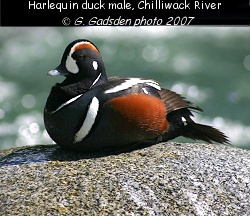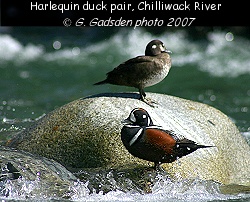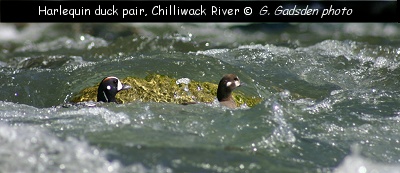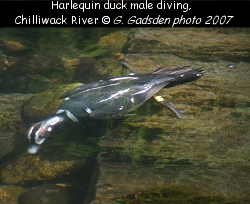The Harlequin Duck
By Gord Gadsden
June 2007
Harlequin ducks, named for the male's stunning colours, are a amall sea duck species with an  interesting life history. interesting life history.
While most commonly seen on the coast in rocky marine habitats, they often come inland during the summer to breed. Harlequin ducks that winter on the coast in the Straight of Georgia will travel east as far as extreme western Alberta to breed in streams and rivers. The summer is when we're most likely to encounter this species in our area.
Starting in early May, males and females begin to stage in clear and swift-flowing small rivers and large streams such as the upper Chilliwack River and Skagit River. Here they feed on stream invertebrates and look for salmon eggs from spawning steelhead and trout. Excellent divers and strong swimmers, they are able to navigate heavy flows and dive in the swift current and search among the rocks on the stream bottom for food.
Breeding occurs in our area in clear swift flowing streams with plenty of forest cover. After the female begins to incubate the eggs, the male will leave the female and head for the coast. The female creates a nest, most often on the ground not far from water. She incubates an average of 6-8 eggs for around 26 days. Upon hatching, the female will lead her ducklings to the stream or river and will raise them on the swift water. Once the young can fly, they will leave and head back to the coast and rejoin the males. them on the swift water. Once the young can fly, they will leave and head back to the coast and rejoin the males.
Harlequin duck population numbers are stable on the west coast of North America where they occur from Alaska to northern California. The eastern population of harlequin duck is considered endangered and is of special concern. Harlequin ducks also can be found on Greenland and Russia.
Links and sources:
Bird Studies Canada - http://www.bsc-eoc.org/organization/hardpopu.html
Parks Canada - http://www.pc.gc.ca/pn-np/ab/banff/natcul/natcul24_E.asp
Canadian Wildlife Service - http://www.qc.ec.gc.ca/faune/sauvagine/html/hd_new_facts.html
Ehrlich, Dobkin and Wheye, (1988)


|